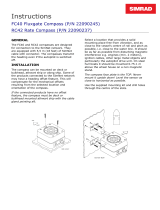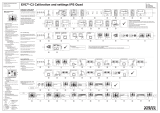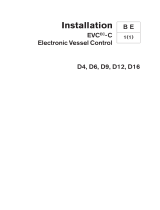Page is loading ...

www.simrad-yachting.com A brand by Navico - Leader in Marine Electronics
Installation manual
Simrad AP24/28 – EVC,
Volvo IPS Pilot System with
SG05 SimNet-Volvo Gateway
English

Installation manual
Simrad AP24/28 – EVC,
Volvo IPS Pilot System with
SG05 SimNet-Volvo Gateway
English
Document no: 20223210
Revision: A
Date: May 2008
The original language for this document is English. In the
event of any discrepancy between translated versions
and the English version of this document, the English
document will be the official version.
To the best of our knowledge, the content in this
publication was correct at the time of printing.
As we are continuously improving our products we retain
the right to make changes to the product and the
documentation at any time. Updated manuals are
available from our website www.simrad-yachting.com,
and are free to download.
© Copyright 2008 by Navico Holding AS.

2 | SG05 Installation manual
About this manual
Rev. A 08.05.08 First issue
This manual is intended as a reference guide for installing
and maintaining a Simrad autopilot system with the
Simrad SG05 SimNet-Volvo Gateway for Electronic Vessel
Control.
Please take time to read this manual to get a thorough
understanding of the system components and their
relationship to a complete autopilot system.
Important text that requires special attention from the
reader is emphasized as follows:
Used to draw the reader’s attention to a comment or
some important information.
Used when it is necessary to warn personnel that a
risk of damage to the equipment or hazard exists if
care is not exercised.

SG05 Installation manual | 3
Content
1 System description ..................................... 5
1.1 General ..................................................5
1.2 How to use this manual.............................5
1.3 Software record.......................................6
2 Installation................................................. 7
2.1 Installation checklist.................................7
2.2 Unpacking and handling............................7
2.3 Determine system configuration.................8
2.4 Autopilot system layout.............................9
2.5 SG05 Gateway installation.......................10
2.6 AP24 and AP28 Control unit installation.....11
2.7 RC42 Compass installation ......................13
2.8 Interfacing............................................14
2.9 SimNet.................................................15
3 Spare parts............................................... 19
4 Technical specifications............................ 21
4.1 Autopilot System ...................................21
4.2 AP24 Control Unit...................................23
4.3 AP28 Control Unit...................................24
4.4 SG05 Gateway....................................... 25
4.5 RC42 Rate Compass...............................26
4.6 AT10 SimNet/NMEA0183 converter...........27
4.7 SimNet.................................................29

System description | 5
1 System description
1.1 General
The Simrad SG05 is a gateway for interfacing the AP24
and AP28 autopilot systems to Volvo Penta Electronic
Vessel Control (EVC). It contains the steering computer
and provides interface to other system components.
It communicates on the proprietary SimNet data and
control network to establish a reliable digital
communication and power distribution between the units
in the autopilot system as well as other Simrad products.
SimNet provides high speed data transfer and control of
Simrad products integrated in a total steering and
navigation system.
1.2 How to use this manual
This manual is intended as a reference guide for installing
and maintaining the Simrad SG05 Gateway and other
components in an autopilot system.
Please take time to read this manual to get a thorough
understanding of the system components and their
relationship to a complete autopilot system.
Other documentation material that is provided with your
system includes an operator manual which includes the
setup instructions for the system, a control unit
installation guide and a warranty card. The warranty card
must be filled out by the authorized dealer that
performed the installation.

6 | System description
1.3 Software record
Control units
When the system is switched on, a status display shows
the serial number and software version for the control
unit.
The shown readout is only an example!
SimNet sources
Serial number and software version for other SimNet
sources can be found under the control unit User setup
menu. Refer to Manual source selection in the autopilot
operator manual.

Operation | 7
2 Installation
An autopilot system includes several units that need to
be mounted in different locations on the boat, and also
need to connect with at least three different systems on
the boat:
• EVC Autopilot Interface
• The boats electrical system (12V SimNet power)
• Other equipment on board (SimNet/NMEA interfacing)
In addition, the advanced capabilities of the system
require the installer to perform a series of settings and
tests to verify proper operation of the system, refer to
the check list below.
2.1 Installation checklist
1. Determine the system configuration you are
installing (Page 8)
2. Perform the hardware i
nstallation (Page 10)
3. Connect Si
mNet devices to SimNet (page 15)
4. Perform S
et-up (refer to Operator manual)
5. Test Autopilot Operation at Sea (refer to Sea Trial
instructions in the Operator manual)
2.2 Unpacking and handling
Care should be taken when unpacking and handling the
equipment. A visual inspection should be made to see
that the equipment has not been damaged during
shipment and that all components and parts are present
according to the packing list.

8 | Operation
An autopilot system will include:
• Control unit (AP24 or AP28) with accessories
• SG05 Gateway with accessories
• Compass (RC42) with 5,5 m (18') SimNet cable
attached
• Optional equipment that may have been ordered for
the installation.
2.3 Determine system configuration
It is important to become familiar with the configuration
of the system prior to beginning the installation. An
autopilot basic single station system with optional station
is shown in Figure 2-1
Pl
an your cabling and configure the SimNet network in
accordance with chapter 2.9 on page 15.
As most of th
e units are communicating on a common
network (SimNet) with identical connectors, the
installation is simple. Try to mount the units within the
standard cable length supplied with each unit. SimNet
cables are available from your distributor (see page 20)
for connecti
on to other SimNet devices and cable
extension.

Operation | 9
2.4 Autopilot system layout
AP24
Control Unit
RC42 Rate Compass
SG05 Gateway
24
AP
MODE
MENU
AUTO
STBY
TUR N
1010
PWR
1
1
12V SimNet supply
(SimNet cable with termination
)
To EVC connect point *
AP28
Control Unit
PWR
NAV WI N DTURN
STBY
DRIFT
NO-
AUTO
MENU
Figure 2-1
RC42 Rate Compass
AP24
Control Unit
AP28
Control Uni
t
SG05 Gateway
24AP
MODE
MENU
AUTO
STBY
TURN
10
10
PWR
1
1
12V SimNet supply
(SimNet cable with termination)
To EVC connect point *
PWR
NAV WI N DTURN
STBY
DRIFT
NO-
AUTO
MENU
Figure 2-2
* The EVC connect point is a connector on the Volvo
Penta Autopilot Interface kit. It can be ordered from
Volvo Penta under P/N 3819744 (See Figure 2-4).

10 | Operation
2.5 SG05 Gateway installation
• The SG05 is bulkhead mounted by the enclosed
screws. The SimNet connectors must be pointing
downwards. Figure 2-3.
• Connect other uni
ts according to Figure 2-1. Use only
readymade S
imNet cables and accessories. For
SimNet network termination refer to section 2.9 on
page 15.
• Connect 12V SimNet supply. Refer to Figure 2-10 for
correct pol
arity
• Connect the 1 m pigtail plug into mating connector of
the Volvo Penta Autopilot Interface. Figure 2-4
SG05 has a built in LED that will alternate with 1 Hz when
the unit is up running.
Figure 2-3 SG05 mounting
Simrad SG05
Gateway
Autopilot Interface kit
(Volvo Penta part number 3819744)
Autopilot
Gateway
EVC connect point
Y-split
cable
Figure 2-4 SG05 connection to Volvo Penta Autopilot Interface

Operation | 11
2.6 AP24 and AP28 Control unit
installation
Avoid mounting the control unit(s) where it is easily
exposed to sunlight, as this will shorten the lifetime of
the display.
Do not install the control unit where moisture is
present at the rear. It may cause damage by
entering the breathing hole or by coming into
contact with the electrical connectors.
Panel mounting
The mounting surface must be flat and even to within 0.5
mm.
• Drill the 4 mounting holes and make a panel cut-out
according to supplied template.
• Connect the SimNet cable(s) to the control unit
connector(s)
• To daisy chain units remove the blocking plug with a
pair of pliers.
• Use the supplied 19 mm screws to fasten the control
unit to the panel.
• Apply the front panel corners.
Do not over-tighten the mounting screws!
Figure 2-5 AP24 Panel mounting

12 | Operation
Optional bracket mounting
Figure 2-6 AP24 Bracket mounting
Figure 2-7 AP28 Panel mounting

Operation | 13
Figure 2-8 AP28 Bracket mounting
2.7 RC42 Compass installation
Figure 2-9 Mounting
The heading sensor is the
most important part of the autopilot system and great
care should be taken when deciding the mounting
location. As the heading is displayed on the control unit,
the heading sensor can be mounted at a remote location.
The compass can be mounted on deck or bulkhead,
athwart ship or along ship. Some of the products
connected to the SimNet network may have a heading
offset feature. This will compensate for the mechanical
offsets that may be a result of the selected location and
orientation of the compass.

14 | Operation
If the connected products have no offset feature, the
compass must be deck or bulkhead mounted athwart ship
with the cable gland pointing back.
Select a location that provides a solid mounting place free
from vibration, and as close to the vessel's centre of roll
and pitch as possible, i.e. close to the water line. It
should be as far as possible from disturbing magnetic
interference e.g. engines (min. 2 meters), engine ignition
cables, other large metal objects and particularly the
autopilot drive unit. On steel hull boats it should be
mounted 0,75-1 m above the wheel house on a non
magnetic stand.
The compass face plate is the TOP. Never mount it upside
down! Level the sensor as close to horizontal as possible.
Use the supplied mounting kit and drill holes through the
centre of the slots.
Connect the compass to an available SimNet connector in
the SimNet “backbone”.
2.8 Interfacing
With the autopilot system there are several possibilities
to connect to other equipment for data collection and
exchange:
1 Use SimNet
2 Use SimNet via AT10 Universal SimNet/NMEA
Converter
3 Connect to a NMEA2000 network via adapter
(drop) cable, part no. 24005729.
The different connecting diagrams on the following pages
illustrate the interface possibilities of the autopilots.

Operation | 15
2.9 SimNet
The SimNet cable system with very small plugs in both
ends makes it easy to run the cables, only 10 mm (3/8”)
holes are required through panels and bulkheads. The
SimNet accessory program contains the necessary items
to make a successful installation. Refer to SimNet
cables and accessories, page 20.
SimNet network cables
A SimNet unit has one or two yellow SimNet connectors.
There are no dedicated “in” or “out” connectors. Route
the SimNet cables with Figure 2-11 or Figure 2-12 as a
gui
deline. Select cables and accessories from the SimNet
accessory program. Connect products with two SimNet
connectors in a daisy chain and use drop cables and T-
joiners when required. For cable extension in-line cable
joiners are available. Total length of SimNet cable
installed in a system should not exceed 150 meter (500’).
If you plan to extend your SimNet system in the future it
may be advantageous to prepare for it by adding a few T-
joiners in central locations. The T-joiners provide easy
access to the network and can be replaced with a new
product, or the new product can be connected via a drop
cable.
The connectors are weather proof according to IP66,
when properly installed. All unused SimNet connectors
must be fitted with the plastic cap to protect them against
dirt and moisture.
SimNet power and termination
The following rules should be observed when installing
SimNet.
1 It must have a separate 12VDC power from the
battery bus or the circuit breaker board to reduce
interference
2 It will power a SimNet compatible instrument
system. Hence SimNet to other equipment can be

16 | Operation
supplied via the autopilot, see Figure 2-11 and
Figure 2-12.
3 S
imNet must be properly terminated, i.e. unless it
is a small system (see Figure 2-1 and Figure 2-2)
there must be terminations at each end of the
Simrad backbone.
The SimNet network has to be terminated according to
the number and type of products connected.
For additional information about SimNet ask for the
separate SimNet Manual.
Figure 2-10 SimNet Power connection
AP24
Control Unit
IS20
Instrument
IS20
Instrument
24
AP
MODE
MENU
AUTO
STBY
TURN
1010
PWR
1
1
Multijoiner
RC42
12V SimNet supply
(SimNet cable without termination)
Wind
transducer *
AT45
NX45 NavStation
Active depth
transducer
Analog
speed/temp
sensor
SG05
To EVC connect point
Termination
plug
Figure 2-11 SimNet network, medium system

Operation | 17
GS10
RS82
WR20
WB20
RS82
Black box
SIMRAD RS82
WR20
SG05
NX45 NavStation
AP24
Control Unit
AP28
Control Unit
IS20
Instrument
IS20
Instrument
24
AP
MODE
MENU
AUTO
STBY
TURN
1010
PWR
1
1
Multijoiner
RC42
12V SimNet supply
(SimNet cable without termination)
Active depth
transducer
Analog
speed/temp
sensor
Wind
transducer *
AT45
PWR
NAV WI N DTURN
STBY
DRIFT
NO-
AUTO
MENU
To EVC connect point
Termination
plug
Figure 2-12 SimNet network, expanded system
1. Maximum total length of SimNet cables is 150 m
(500 ft.)
2. Drop cables must not exceed 6 m (19 ft) of length
and the total length of drop cables must not exceed
60 m (200 ft).
3. Equipment should not be daisy-chained in a drop
cable.
4. The wind transducer (*) has a built in terminator.

18 | Operation
Blank page

Spare parts | 19
3 Spare parts
AP24 Control Unit
22096614 AP24 Control Unit
22096630 Mounting kit consisting of:
22095483 Cabinet corners (6)
44165181 Screw 3,5x19 (4)
24006355 SimNet blocking plug
22096820 Optional mounting bracket kit
24006355 SimNet blocking plug
22096515 AP24 Weather Cover
AP28 Control Unit
22096622 AP28 Control Unit
22096630 Mounting kit consisting of:
22095483 Cabinet corners (6)
44165181 Screw 3,5x19 (4)
24006355 SimNet blocking plug
22096820 Optional mounting bracket kit
24006355 SimNet blocking plug
22096572 AP28 Weather Cover
SG05 SimNet-Volvo Gateway
24006793 SG05 SimNet-Volvo Gateway w/acc.
24006686 SG05 SimNet-Volvo Gateway
44149292 Screw 3,5x10 (2)
RC42 Rate Compass
22090195 RC42 Rate Compass w/accessories
22081442 Installation Accessories Consisting of:
20104972 Mounting plate (2)
44140762 Screw 3.5x25 (2)
44140770 Screw 30x9 (4)
22081376 Plug (2)
24006363 SimNet Cable, 5.5 m (18’) with one plug
/







